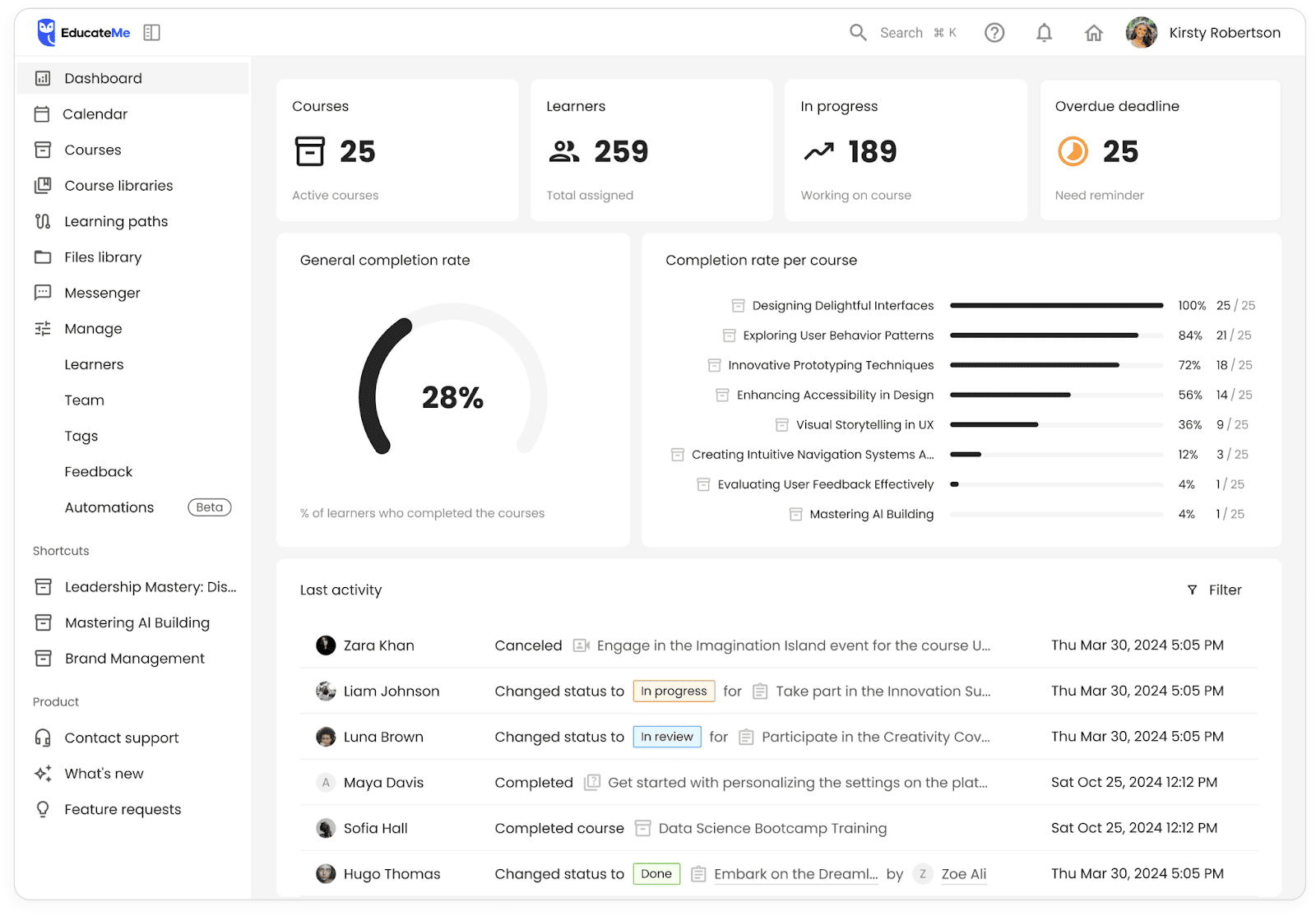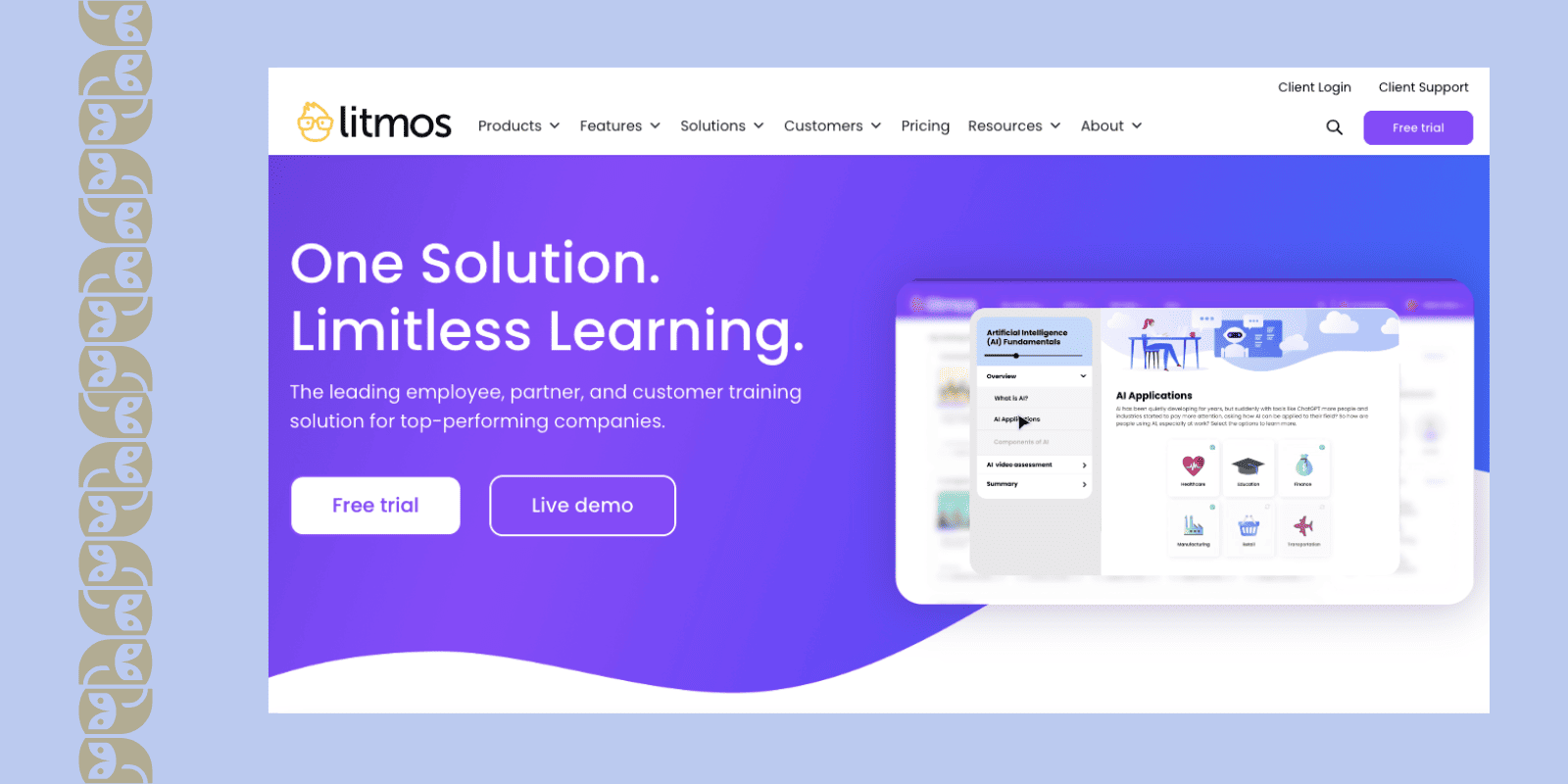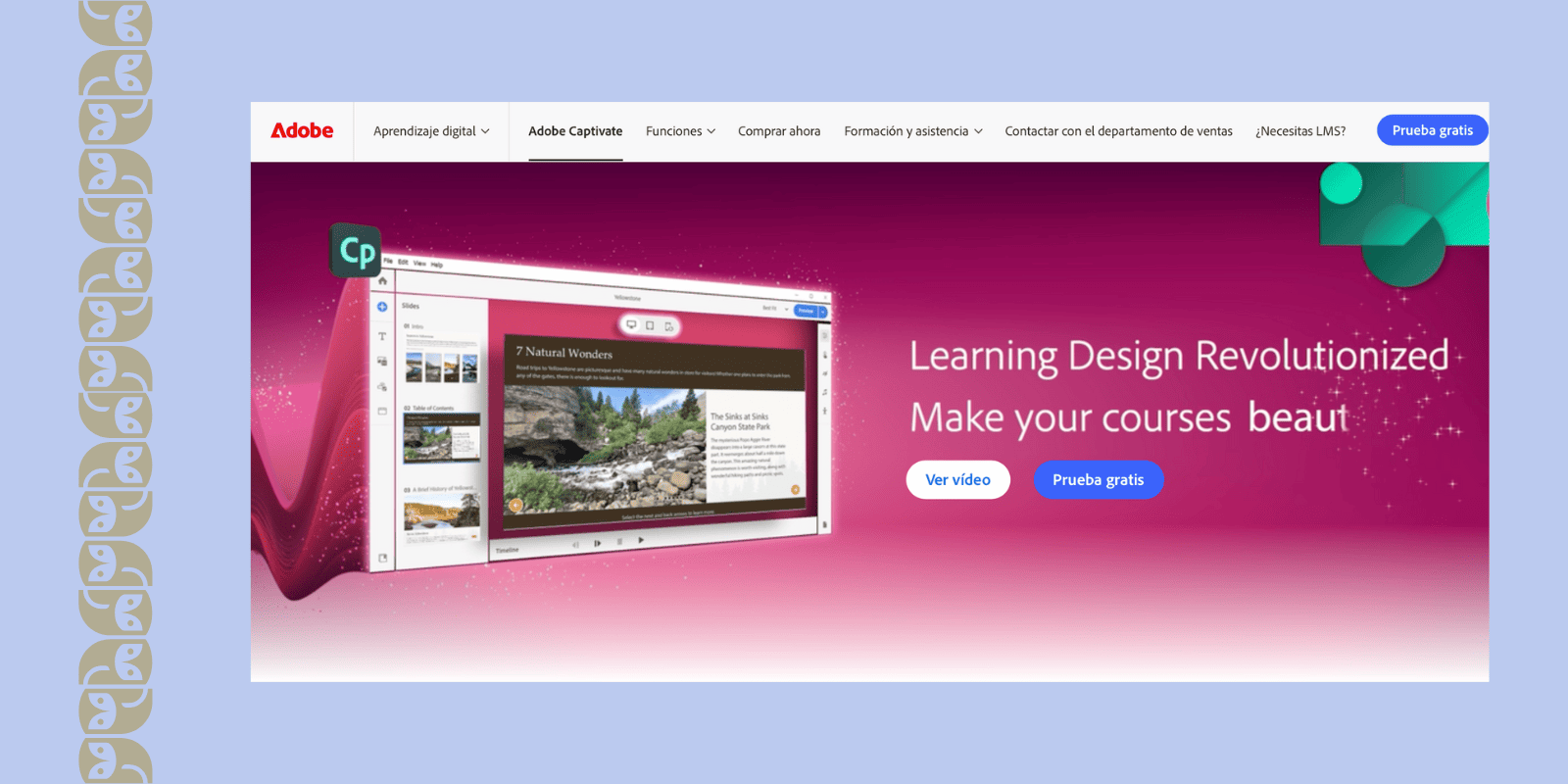he concept of gamification emerged quite a long time ago but only gained traction in recent years. Its origins can be traced back to the gaming industry, but the pioneers of integrating game mechanics into other domains were Richard Brenner and Ian Kenny of Bunchball. In 2010, they introduced a gamification system on the popular NBC website, enabling users to accumulate points and earn rewards for engaging in various online activities.
Since then, gamification has permeated diverse fields, encompassing business, healthcare, politics, etc., and online education isn’t an exception.
In today’s article, we'll explore seven examples of LMS with gamification elements to enhance the learning experience significantly.
What is LMS gamification?
LMS gamification is a strategy that integrates game-like elements, such as points, badges, leaderboards, awards, etc. into Learning Management Systems to motivate and engage learners.
The gamification in LMS has already demonstrated its efficacy compared to traditional methods. Games resonate with individuals of all ages, thus finding utility across educational realms — from primary and higher education to corporate training and online courses. Through gaming, mundane tasks become engaging, and complex concepts become digestible. Games immerse individuals in the learning process and facilitate information retention.
What are key LMS gamification elements?
There are different ways to implement gamification in distance learning. Below, we list the most popular examples.
Storyline
Create an interesting storyline — a story that will captivate users as they explore it. E-learning should feel like an exciting journey. For example, you can imagine vocational training as a path to preventing a global catastrophe or solving a problem. Add characters to this story so that the person can improve their avatar.
Game levels
Use different levels that open as your learners complete tasks. Then users become interested in “What will happen next?” Levels help them feel progress as they progress through the game. To enhance this effect, indicate as a percentage how much of the path the person has walked.
In corporate training, it is convenient to combine progression methods with the grade system of positions in the company - when an employee receives the next grade (for example, from a 1st level manager to a 2nd level manager), they open a new level in the game.
💡 Tip: After passing the next level, you can issue certificates to students. They are not only displayed in the user profile, they can be downloaded and printed.
Point system
Award points for completing various tasks. Reward students for easy tasks first, then increase the difficulty and score.
For example, you can get 2 points for completing a simple lesson, and 5 points for a difficult lesson. The point system works very effectively in conjunction with ratings. A person sees how they have progressed concerning themselves and other people. The ranking and lag behind the leader stimulate the student to make additional efforts.
💡Tip: Points can be exchanged for nice bonuses in the gift shop.
Badges
Badges or medals are rewards in the form of a virtual item or pinned image on a user's profile. This is a great way to highlight and reward someone for their efforts. For example, you can mark an excellent answer with a badge. Or the person who completed the training the fastest.
Badges should be visible to other players. At the same time, unique rewards that are difficult to earn are precious. They make a person stand out from other students. It’s good if the icons are related to a person’s real life and work. That means they should have weight in the real world as well, not just in the game universe.
Visual design
Use attractive visuals and a nice design to make it easy and comfortable for users to interact with the content and make them look forward to new lessons.
And so that students can see all their awards in one place, you can use dashboards in the user profile - this is a quick summary of various indicators on one page.
Competition
Rankings are great for creating healthy competition among students. Everyone strives to be the best and to see their name at the top of the list, so they study more actively. You can divide all users into several groups and make separate ratings for each group. This will increase students' motivation as they will have a better chance of topping the table.
Feedback
Providing instant feedback when a person has completed a task or test is a great way to keep them focused and engaged. Immediately after completing the task, tell them - did they win or lose? This feedback enables learners to monitor their progress as they advance through the different stages of the game.
#1. EducateMe

EducateMe exemplifies an LMS with gamification that transcends corporate learning boundaries. With its robust collaborative learning platform, emphasis on engagement, and streamlined learning management, EducateMe caters to diverse sectors and quickly adapts to the client's business needs. Moreover, its transparent pricing model, comprehensive support, and wide range of analytics further enhance its appeal as a versatile and effective gamification LMS solution.
Gamification Features
- Analytics-driven Gamification. You can leverage comprehensive analytics to track learner performance, course progress, and engagement metrics. It empowers instructors to design personalized gamification strategies tailored to individual learning journeys.
- Certificates as Achievements. Utilize the certificates feature to recognize learner accomplishments and milestones. This feature allows you to tangible reward students for completing courses or mastering specific skills within the platform.
- Progression-based Learning. Implement bite-sized content and drop scheduling to gamify the learning experience by unlocking subsequent modules or content only upon completion of previous sections.
- Customizable Gamification Pages. Harness the power of free building to create customized pages within the platform's main menu. It enables instructors to design gamified experiences with such elements as leaderboards, point systems, and interactive challenges.
Pricing: 14-day free trial; $100/month for Advanced Plan, $200/month for Pro Plan, and Enterprise Plan starts from $1250/month.
#2. Docebo

Docebo is a gamified LMS that combines formal, social, and collaborative learning. Utilizing Docebo, you can reward students with points and badges for successfully completing assignments. The system also allows you to add a competitive element through ratings, and upon completion of courses and tests, assign rewards and gifts to users. For example, you could upload a restaurant gift certificate to the first or best course completer.
Gamification Features
- Points, Awards, and Badges. This feature allows you to acknowledge and incentivize learner progress and achievements through a system of points, awards, and badges, thereby enhancing engagement and motivation.
- Leaderboards and Contests. With Docebo, you can foster healthy competition and encourage knowledge retention. You can implement leaderboards and contests to track progress and reward top performers.
- Reward Marketplace. With this feature, you can establish a centralized platform where learners can redeem their accumulated points for rewards.
- Customized Gaming Experiences. Tailor gamification experiences to suit different learner groups with this feature, ensuring engagement and relevance across diverse organizational branches.
- Progress Tracking and Reward Management. Monitor learner engagement and success centrally with this feature, facilitating efficient management of rewards and recognition within the learning environment.
Pricing: Engage Plan — from $25,000/year; Elevate Plan — from $40,000/year and Enterprise — with custom pricing. This pricing is based on a 3-year contract.
#3. TalentLMS

TalentLMS is a dynamic Learning Management System that gamifies the eLearning experience, offering features like points, badges, levels, leaderboards, and tangible rewards. It motivates users by turning training into an engaging journey, boosting learner engagement and retention through interactive learning management system gamification techniques.
Gamification Features
- Progressive Point Allocation. TalentLMS enables you to configure point rewards for various actions and allows customization based on user activity frequency.
- Milestone Badges. Users can unlock badges representing their achievements at predetermined milestones, motivating continuous learning.
- Skill Development Levels. This LMS offers a structured leveling system tied to users' points, completed courses, and earned badges. With this feature, you can guide learners through progressive skill development stages and provide clear goals for advancement.
- Interactive Leaderboards. TalentLMS incorporates dynamic leaderboards based on users' performance metrics.
- Tangible Rewards Integration. You can convert virtual achievements, such as points, badges, and levels, into tangible rewards such as course discounts. That way you can inspire learners to actively participate and excel in their training endeavors.
Pricing: Starter plan — $89/month; Basic — $189/month; Plus — $369/month; Premium — $569/month. For an annual subscription, discounts are available.
#4. Litmos

Litmos is an eLearning LMS gamification solution that integrates learning management, advanced enterprise administration, pre-built content, and a content management system.
Gamification Features
- Leaderboards. Litmos promotes friendly competition through leaderboards, where learners can track their rankings based on points or course completions.
- Points System. The points system incentivizes learner engagement by awarding points for completing courses and participating in activities. It drives progress and competitiveness within the learning community.
- Badges and Rewards. Litmos encourages learning progression with a variety of badges and rewards, serving as visual markers of achievement and skill acquisition.
Pricing: To get prices for Litmos LMS you need to contact their sales department.
#5. Adobe Captivate

Adobe Captivate is a powerful LMS with gamification functionality for creating learning content of varying levels of complexity: from simple slide courses to simulators with virtual reality elements. In this LMS learners can compete with their colleagues to score points for various learning activities and achieve bronze, silver, gold, and platinum levels.
Gamification Features
- Points for Consistent Learning. Adobe Captivate incentivizes regular engagement by awarding points to learners who consistently participate in learning activities over specific periods.
- Tasks with Points Allocation. Learners are encouraged to achieve various learning milestones through specific tasks, such as completing courses within set time frames or achieving competency levels, earning them points that contribute to their overall gamification score and progression.
- Leaderboard Competition. Adobe Captivate introduces friendly competition among learners by displaying a leaderboard that showcases individual rankings based on points earned.
- Achievement Levels. Learners can attain different levels of achievement, including Bronze, Silver, Gold, and Platinum, based on the cumulative points they accumulate throughout their learning journey.
Pricing: For Individuals — $33.99/month; For Teams and Enterprises — To find out the price, you'll need to get in touch with the Adobe sales team.
#6. eFront

eFront is a flexible, open-source gamifying LMS suitable for training employees, partners, and clients in companies and organizations. The software solution seamlessly integrates with a range of IT infrastructure options and scales alongside the client company's expansion.
Gamification Features
- Points. Users earn points for various actions within the LMS, such as completing courses or logging in. It can help you to ignite a competitive spirit, and get a visual representation of progress.
- Badges. Badges are unlocked for achievements, ranging from basic milestones to more challenging accomplishments.
- Levels. Users progress through hierarchical levels based on their accumulated points, course completions, or badge achievements, mirroring the sense of advancement seen in promotions or educational milestones.
- Leaderboards. Leaderboards display user rankings in various metrics, showcasing top performers and allowing users to compare their progress with peers in their branch.
Pricing: Registered - Starting from $1,200/m; Active - Starting from $2,000/m; On-premises - Price tailored.
Final Thought
Gamification in education serves as a powerful tool to spark curiosity and engagement among learners of all ages, be it children or adults. It's a versatile approach that effectively cultivates interest and promotes active participation in the learning process.
Incorporating gamification into learning management systems enriches the educational experience by providing interactive and immersive learning environments. Try a 14-day free trial of EducateMe to seamlessly integrate gamification elements to enhance learner engagement and motivation.























